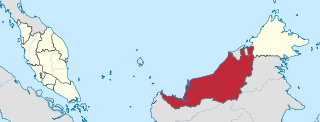
Sarawak is a state of Malaysia. The largest among the 13 states, with an area almost equal to that of Peninsular Malaysia, Sarawak is located in the region of East Malaysia in northwest Borneo, and is bordered by the Malaysian state of Sabah to the northeast, Kalimantan to the south, and Brunei in the north. The capital city, Kuching, is the largest city in Sarawak, the economic centre of the state, and the seat of the Sarawak state government. Other cities and towns in Sarawak include Miri, Sibu, and Bintulu. As of the 2020 Malaysia census, the population of Sarawak was 2.453 million. Sarawak has an equatorial climate with tropical rainforests and abundant animal and plant species. It has several prominent cave systems at Gunung Mulu National Park. Rajang River is the longest river in Malaysia; Bakun Dam, one of the largest dams in Southeast Asia, is located on one of its tributaries, the Balui River. Mount Murud is the highest point in the state. Sarawak is the only state of Malaysia with a Christian majority.

Kuching, officially the City of Kuching, is the capital and the most populous city in the state of Sarawak in Malaysia. It is also the capital of Kuching Division. The city is on the Sarawak River at the southwest tip of Sarawak on the island of Borneo and covers an area of 431 km2 (166 sq mi) with a population about 165,642 in the Kuching North administrative region and 159,490 in the Kuching South administrative region—a total of 325,132 people.

Sibu is a landlocked city located in the central region of Sarawak, Malaysia. It serves as the capital of Sibu District within Sibu Division and is situated on the island of Borneo. Covering an area of 129.5 square kilometres (50.0 sq mi), the city is positioned at the confluence of the Rajang and Igan Rivers, approximately 60 kilometres from the South China Sea and 191.5 kilometres (119 mi) north-east of the state capital, Kuching.

Simanggang is a town and the capital of Sri Aman District and Sri Aman Division in Sarawak, east Malaysia. Located on the Lupar River, it is 193 kilometres (120 mi), a three-hour drive, from Kuching, the capital of Sarawak. It is a trade center for the timber, oil palm, rubber, and pepper of its mostly agricultural district.

The White Rajahs were a dynastic monarchy of the British Brooke family, who founded and ruled the Raj of Sarawak, located on the north west coast of the island of Borneo, from 1841 to 1946. The first ruler was Briton James Brooke. As a reward for helping the Sultanate of Brunei fight piracy and insurgency among the indigenous peoples, he was granted the province of Kuching, which was known as Sarawak Asal in 1841 and received independent kingdom status.
Tun Abang Haji Openg bin Abang Sapiee was a Malaysian politician who served as the first Yang di-Pertua Negeri of Sarawak from September 1963 to his death in March 1969. He assumed the newly established post following Sarawak's independence from Great Britain and the formation of Malaysia in 1963.

This article lists important figures and events in Malayan and Malaysian public affairs during the year 1963, together with births and deaths of significant Malaysians. The Federation of Malaya merged with Singapore, North Borneo, and Sarawak to form the Federation of Malaysia on 16 September.

The Raj of Sarawak, also Kingdom of Sarawak or State of Sarawak, located in the northwestern part of the island of Borneo, was an independent state founded in 1841, in a treaty of protection with the United Kingdom starting from 1888. It was established from a series of land concessions acquired by an Englishman, James Brooke, from the Sultan of Brunei. Sarawak was recognised as an independent sovereign state by the United States in 1850 and by the United Kingdom in 1864. The Kingdom is now the Malaysian state of Sarawak.

Bintulu is a coastal town on the island of Borneo in the central region of Sarawak, Malaysia. Bintulu is located 610 kilometres northeast of Kuching, 216 kilometres northeast of Sibu, and 200 kilometres southwest of Miri. With a population of 114,058 as of 2010, Bintulu is the capital of the Bintulu District of the Bintulu Division of Sarawak, Malaysia.
Edward (Bill) Banks (1903–1988) was a British administrator, amateur naturalist and museum curator.
Benedict Sandin was a Malaysian ethnologist and historian, who was Curator of the Sarawak Museum in Kuching, Sarawak from December 1966 to March 1974. He also served as Government Ethnologist to the Government of Sarawak. He wrote many ethnographic articles in the Sarawak Museum Journal and a book entitled "The Sea Dayaks of Borneo: Before White Rajah Rule".

The History of Sarawak can be traced as far as 40,000 years ago to the paleolithic period where the earliest evidence of human settlement is found in the Niah caves. A series of Chinese ceramics dated from the 8th to 13th century AD was uncovered at the archeological site of Santubong. The coastal regions of Sarawak came under the influence of the Bruneian Empire in the 16th century. In 1839, James Brooke, a British explorer, first arrived in Sarawak. Sarawak was later governed by the Brooke family between 1841 and 1946. During World War II, it was occupied by the Japanese for three years. After the war, the last White Rajah, Charles Vyner Brooke, ceded Sarawak to Britain, and in 1946 it became a British Crown Colony. On 22 July 1963, Sarawak was granted self-government by the British. Following this, it became one of the founding members of the Federation of Malaysia, established on 16 September 1963. However, the federation was opposed by Indonesia, and this led to the three-year Indonesia–Malaysia confrontation. From 1960 to 1990, Sarawak experienced a communist insurgency.

The Astana is a palace in Kuching, Sarawak, Malaysia, on the north bank of the Sarawak River, opposite the Kuching Waterfront. It is the official residence of the Yang di-Pertua Negeri Sarawak, the governor of Sarawak. The name is a variation of 'istana', meaning 'palace'. It was built in 1870 by the second White Rajah, Charles Brooke, as a wedding gift to his wife, Margaret Alice Lili de Windt. The palace is not normally open to the public, although the landscaped gardens are, which can be reached by a boat ride across the Sarawak River. It is part of the Kuching Heritage Trail.

Fort Margherita is an old fort constructed in 1879 by Charles Brooke, Rajah of Sarawak, situated in Kuching, Sarawak, Malaysia. The fort is an important landmark and monument in Sarawak's history which goes back to the Brooke dynasty. The fort, built in the style of an English castle, was designed to protect Kuching from being attacked by pirates. It served as a Police Museum from 1971 before being handed over to the Government of Sarawak and now is a tourist attraction in Kuching. The fort now houses the Brooke Gallery, an exhibition showcasing the history of Sarawak under the Brooke dynasty.

The Fort Sylvia is a historical fort in Kapit, Sarawak, Malaysia. Built in 1880, it was renamed after Rani Sylvia Brooke, wife of Rajah Charles Vyner Brooke, in 1925. During the 1960s, the fort housed the District Office and the District Court House, and later the Resident's Office when Kapit Division was formed in 1973.

The Crown Colony of Sarawak was a British Crown colony on the island of Borneo, established in 1946, shortly after the dissolution of the British Military Administration. It was succeeded as the state of Sarawak through the formation of the Federation of Malaysia on 16 September 1963.

Jason Desmond Anthony Brooke FRAS is the grandson of the last Rajah Muda of Sarawak, Anthony Walter Dayrell Brooke, and a prominent representative of the Brooke Dynasty in Sarawak.

The Chinese History Museum Kuching is a museum in Kuching, Sarawak, Malaysia. The museum is about the history of the Chinese people in Sarawak.
Sarawak exhibits notable diversity in ethnicity, culture, and language. The Sarawakian culture has been influenced by Bruneian Malays of the coastal areas. Substantial cultural influences also came from the Chinese and British cultures.

Hong San Si Temple is a Chinese temple situated in Carpenter Street of Kuching, Sarawak, Malaysia. It is part of the Kuching Heritage Trail.























